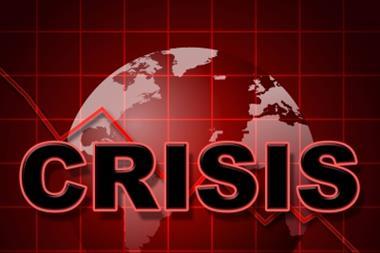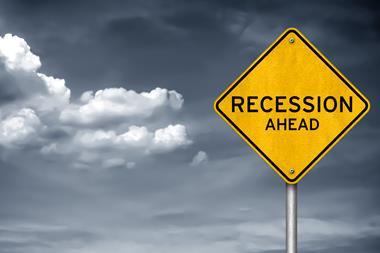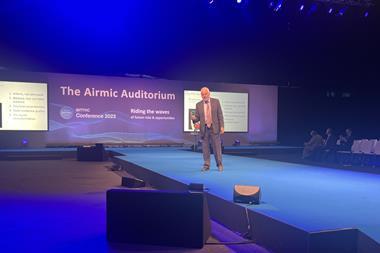Are we in a state of polycrisis or permacrisis? Either way, it’s an interesting time to head up a risk management association. But Airmic CEO Julia Graham only sees this as an opportunity to spotlight the profession, tackling new and evolving risks with a spirit of collaboration.
What impacts do you think the pandemic had on risk management, both in terms of elevating company awareness and changing the way we think about risks?
The last two years have flown by more quickly than any other two years in the time I’ve had the privilege to be part of this fascinating, never dull, profession.
While COVID dominated the risk scene for much of 2020 and continues to have lasting effects, it created often insurmountable problems for many and opportunities for some.
The pandemic was asymmetric and touched organisations in different ways.
Technology companies supporting different ways of working and those able to adapt their existing products and services to meet new and changing needs and lifestyles fared better than those relying on footfall and leisure, many of which faced tough times.
Risk management and risk professionals came to the fore during the pandemic. Some risk management practices, and the strategic significance of risk management were changed forever by COVID.
When we asked Airmic members for their views, they said the profession as a whole had the right competencies to deal effectively with the pandemic, although they thought that knowledge and skills in the assessment of emerging risks and broader strategic thinking could be developed further.
They considered there was a general lack of understanding at different management levels in their organisations about how effective risk management could inform and support better decision-making.
”If these green shoots could apply to other events, and notably to global warming, there remains hope for a better world.”
They concluded that risk professionals need to use the experience and lessons learned during the pandemic to improve alignment of risk management and risk intelligence with the strategic direction of the business.
The focus on Covid was eclipsed during 2021 by other events including extreme weather; in 2022 by the invasion of Ukraine by Russia followed by economic turmoil created by high interest rates and inflation; and this year by a new ’monster coming over the hill’ - AI.
AI isn’t new, it’s the speed at which developments in AI are emerging that is causing alarm with many businesses, educators and regulators who are lagging behind.
Where is the threat of a pandemic now on risk profiles? In many organisations, it’s way down the list, overtaken by new risks that have emerged and existing risks that have changed shape.
Typically, high-impact/low-probability events like a pandemic face the challenge of retaining visibility and attention with a lack of willingness by organisations to look long-term.
The pandemic revealed how fragile societies are, and also how different national responses were. While it exposed a lack of resilience and preparedness by many, it also surfaced green shoots of how organisations and societies could collaborate.
If these green shoots could apply to other events, and notably to global warming, there remains hope for a better world.
In what other ways has the landscape changed over the past two years of your tenure?
Risk leaders cannot address all risks - the world is now so complex and dynamic that everyone must be involved. This scenario demands new risk management tools and techniques - with agility the name of the professional game.
Risks are now more frequent and more intense. They are more likely, as with the pandemic, to be asymmetric and touch most other risks.
The days of risk in silos have gone. Static risk registers and internal audit programmes set annually are inadequate. Both must be dynamic and operate in unison.
Organisations must be equipped to chart uncertain times where change can outpace the ability to respond - as currently with AI. It doesn’t matter which sector or sectors a business operates in, everyone needs to reflect on and review their approach to risk management.
The pandemic demonstrated that many organisations and governments were not prepared for an event with a non-traditional emergency/response/recovery profile - it broke the rules with a model that kept changing as new variants of COVID emerged and as responses varied in effectiveness.
”Risk leaders cannot address all risks - the world is now so complex and dynamic that everyone must be involved.”
There is a growing tendency to examine risk grouped by trends such as technology, climate, geopolitics, geoeconomics and demographics. This helps to organise assessment and develop connectivity.
Risk intelligence must be embedded in decision-making, with constant monitoring and consideration of the internal and external context.
Tools and techniques to scan the horizon and conduct continuous scenario analysis to challenge strategic and operational objectives must be in every risk professional’s back pocket.
But it will not always be those who move most quickly that succeed.
Knowing when to slow down and take stock and maintain a watching brief can be as powerful as knowing when to charge ahead with change often into the unknown - the trick will be knowing when to accelerate and when to decelerate and the risk professional must be in sync with this.
What have been your proudest achievements at Airmic, and what are your ambitions for the future? How do you see Airmic evolving?
The recognition of Airmic as a leader and influencing the transformation of managing risk and insurance with our members and partners is at the top of my list.
Our voice is being heard and our members are more frequently counselled for their opinion. We are vibrant and growing, embracing collaboration with other professions, fuelled by high-octane thought leadership, innovative learning programmes, events and communications.
”Our voice is being heard and our members are more frequently counselled for their opinion.”
But this would be nothing without our members, partners, board and team. Our members help steer our direction through committees, interest groups, networking and surveys and our partners provide inspiration, thought leadership, learning and solutions.
We have a diverse and engaged board guiding us and an amazing Airmic team of professionals I am proud to be a part of.
The WEF watchword is polycrisis. What does this mean for organisations, and how can risk managers prepare for this environment?
The Collins Dictionary word of the year for 2022 was permacrisis. Is it polycrisis or permacrisis?
Polycrisis considers the converging of crisis and the knock-on effects, whereas permacrisis infers a state of permanent crisis. I lean towards permacrisis.
”Risk professionals make excellent crisis managers”
Organisations and governments are never ’off duty’ and crisis management approaches must constantly remain alert and ’ready for business’, whatever the crisis.
Risk professionals make excellent crisis managers. They rose to the surface during the pandemic and have remained there.
No longer the technical adviser who stands at the back of the stage to be called on when needed - they are now centre stage and will remain there.
Blog: Airmic Conference 2023 from Manchester

Daily news summary
- 1
- 2
- 3
- 4
- 5
- 6
- 7
- 8
- 9
- 10
- 11
 Currently
reading
Currently
reading
Airmic 2023: Julia Graham - risk managers are centre stage in a world of permacrisis












































No comments yet